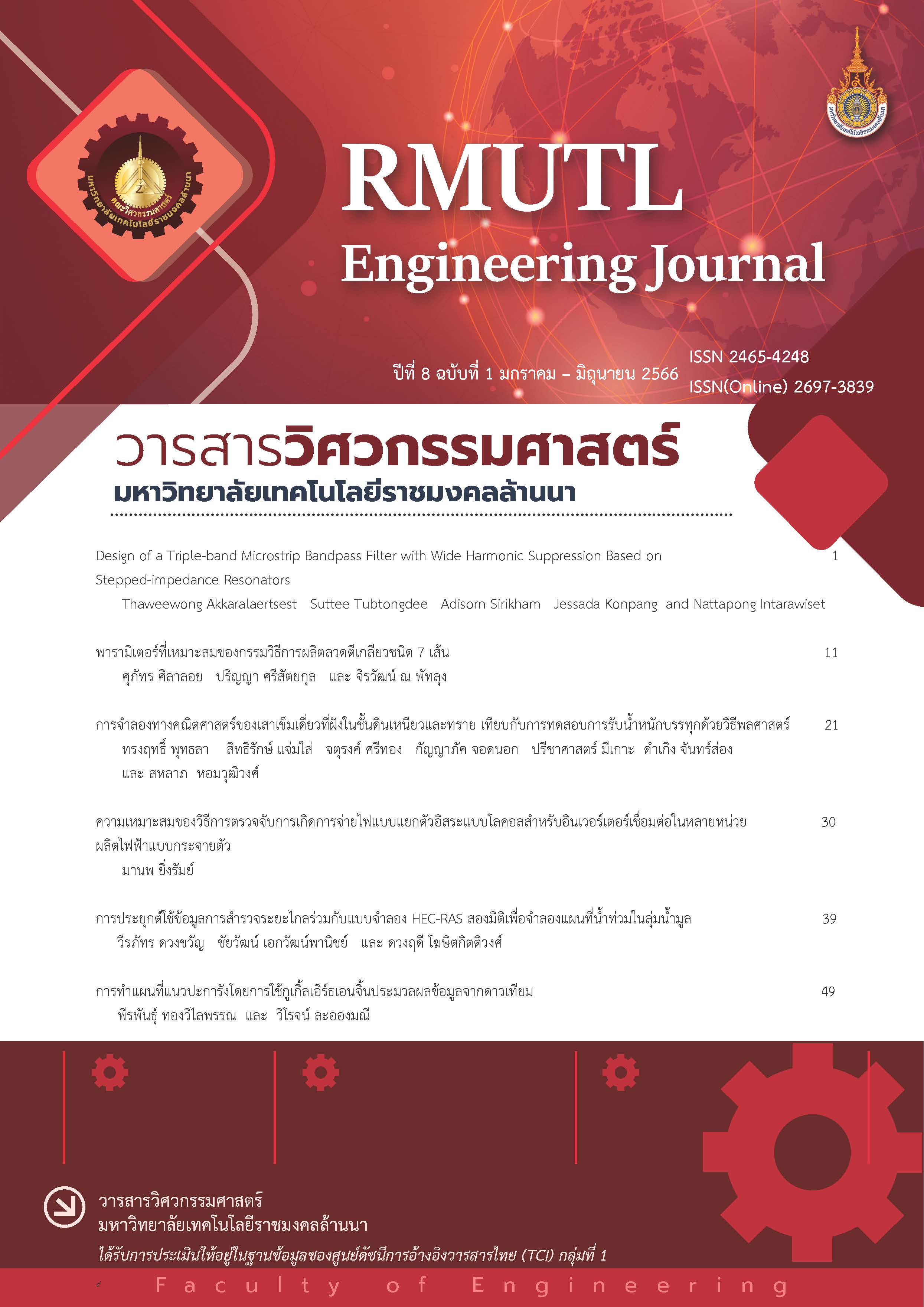Coral Reef Mapping Using Google Earth Engine Satellite Data Processing
DOI:
https://doi.org/10.14456/rmutlengj.2023.6Keywords:
Remote Sensing, Google Earth Engine, Coral Reef MapAbstract
Coral reefs are an important coastal ecosystem in terms of biological and economic points of view. They are vulnerable to both environment change and resource utilization. Therefore, continuous monitoring is necessary for applying the appropriate management. However, the in-situ coral reefs standard method survey is expensive and time-consuming. This study presents the use of Google Earth Engine (GEE) using Sentinel-2 satellite data with a minimum distance classification technique to map coral reefs. Ground truth data for satellite data training and validating was collected using drones. Coral reefs at Rawai beach are classified using this method as 348 rai. The total accuracy of classification is 71% and the kappa coefficient is 0.57. The accuracy of individual classification of sand, coral, and sandy coral is 86.2%, 68.8%, and 58.6%, respectively.
References
Department of Marine and Coastal Resources. Techniques and methods for surveying coral resource status of the Department of Marine and Coastal Resources. [Internet]. 2014 [cited 2022 April 27] Available from: https://bit.ly/3z 3NGnD Thai.
Department of Marine and Coastal Resources. Marine and Coastal Resources Information of Phuket Province. Marine and Coastal Resources Information Center; 2018;34-45 Thai.
Nalinee T. Methods for surveying and collecting specimens in coral ecosystems. Research and Development Institute for Marine, Coastal and Mangrove Forest Resources. Bangkok: Research and Development Institute for Marine, Coastal and Mangrove Forest Resources Department of Marine and Coastal Resources; 2014. Thai.
Lyons M, Roelfsema C, Kennedy E, Kovacs ME, Borrego‐Acevedo R, Markey K, et al. Mapping the world's coral reefs using a global multiscale Earth Observation Framework. Remote Sensing in Ecology and Conservation. 2020;6(4):557–68.
Bennett MK, Younes N, Joyce K. Automating drone image processing to map coral reef substrates using Google Earth engine. Drones. 2020;4(3):50.
Sasithorn S. Algorithm for classifying reef flat condition using THEOS satellite data: a case study at Sirinart National Park, Phuket Province, Thailand. [Thesis]. Prince of Songkla University; 2011.
Siriluk P, Varatip B, Watchara K, Apisit K, Nuttorn K. The assessment of coral situation in Thailand by using geo-informatics technology. RMUTSV Research Journal 2013;5(1):61-77. Thai.
Watchara D, Sawarin L. Water feature extraction using Google Earth Engine. Area Based Development Research Journal. 2020;1(2): 14-23. Thai.
Nattapon Y, Thongthit C. Estimation of wed direct-seeding rice Evapotranspiration in Irrigated Areas of Chao Phraya Basin by using remote sensing technology. In: Pattarapong A, Wanwarang R, Petcharat S, editors. NCCE25. Proceedings of the 25th National Convention on Civil Engineering; 2020 July 15-17; Online Conference Chonburi province; 2020 .p. 2036-42. Thai.
Lyzenga DR. Remote sensing of bottom reflectance and water attenuation parameters in shallow water using aircraft and Landsat data. International Journal of Remote Sensing, 1981;2:71-82.
The European Space Agency. Resolution and Swath. [Internet]. [cited 2022 April 25] Available from: https://sentinels.copernicus.eu/web/sentinel/missions/sentinel-2/instrument-payload/resolution-and-swath.
Wisarut I, Werapong K, Supasit B, Chanida S. An Integrated Field and Remote Sensing Approach for Mapping Seagrass Boundary and Distribution, A Case Study of Paklok Bay, Phuket Province. In: Srisakul P, Supiyanit M, editors. Marine Science 4th:Blue Ocean Science. Proceedings of the 4th Marine Science seminar; 10-12 June 2014. Songkhla province; p.102-112. Thai.
Department of National Parks, Wildlife and Plant Conservation. Coral, the thread of life. [Internet]. [cited 2022 April 17] Available from: https://www.dnp.go.th/park/sara/coralreef/d_coral.htm Thai.
Banerjee M, Capozzoli M, McSweeney L, Sinha D. Beyond kappa: A review of interrater agreement measures. Canadian Journal of Statistics. 1999;27(1):3–23.
Downloads
Published
How to Cite
Issue
Section
License

This work is licensed under a Creative Commons Attribution-NonCommercial-NoDerivatives 4.0 International License.






